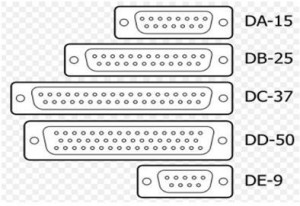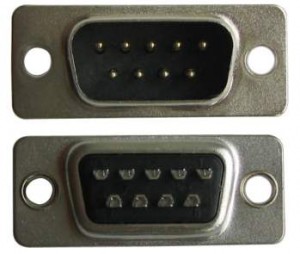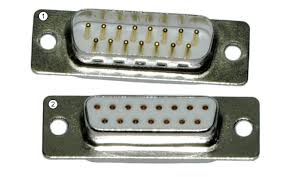D connectors are common electrical connectors especially found in the communication ports of the personal computer. The name is due to its ‘D’ shape itself. The D connector has two or more parallel rows of contacts surrounded by a ‘D’ shaped metal frame. The polarization is automatically achieved in this connector due to this ‘D’ shape. The D connectors were designed by the ITT Cannon in 1952. The D connectors have both male and female connectors and the pin numbers are available from 9 pin to 25 pin contacts.
The image of a male D connector
The specifications of the D-standard connectors are defined by international standard, IEC 60807-3 / DIN 41652. Four different standard connectors are defined under this IEC standard. These connectors primarily differ from each other by their shell size and number of pins. They are named as DA, DB, DC, DD and DE connectors followed by their number of pins. For example the 15 pin standard A connector is named DA-15, the 25 pin standard B connector is named DB-25, the 37 pin C standard connector is named DC-37, the 50 pin D standard connector is named DD-50 and the recently introduced 9 pin E standard connector as DE-9 connector. Many manufactures refer the DE-9 connector as DB-9 since it came as a replacement for the DB-25 connector of the computers RS232 port.
The drawing of different D-standard connectors is shown in the following image.
D standard connectors
Most of these connectors are found as the peripheral connectors of PC. In the following image you can find a few D-standard connectors mounted on a PC cabinet.
D connectors mounted on a PC cabinet
The D connectors which do not follow the above discussed standard are also available like DE15 connectors usually found in VGA cables and High Density (HD) connectors like DB26HD, DB44HD, DB62HD, and DB78HD connectors etc. The D connectors are available with a maximum current rating of 40A and maximum voltage ratings up to 13,500 V.
Now let us go through the common applications and pin-out of some of the D-standard connectors.














Post Comment
You must be logged in to post a comment.